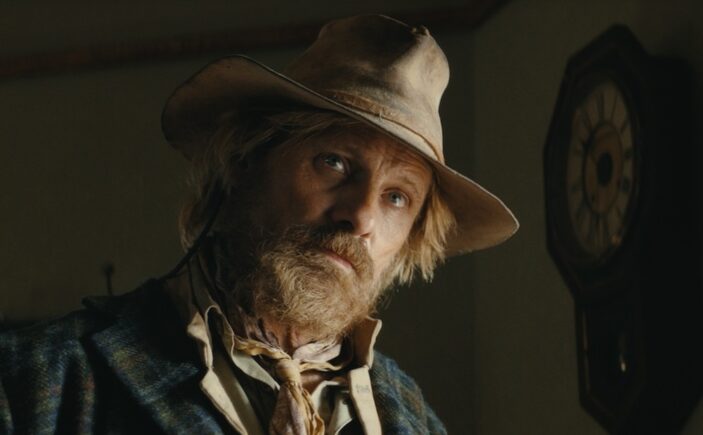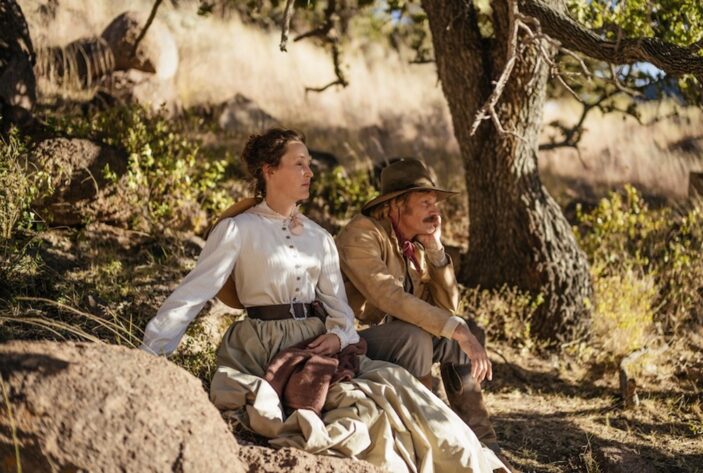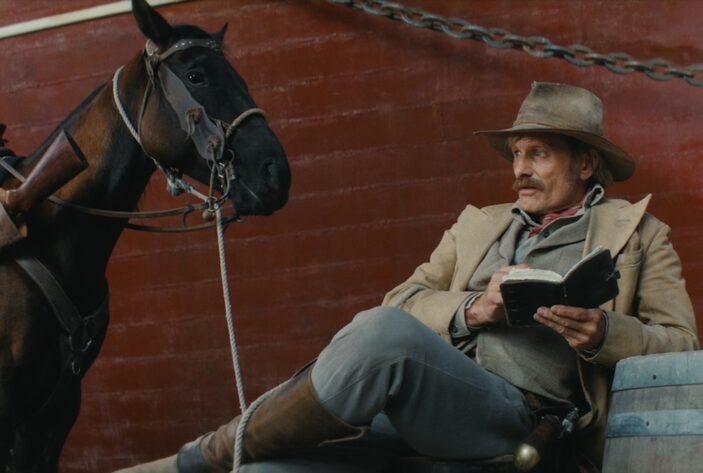
The Dead Don’t Hurt is a story of star-crossed lovers on the western U.S. frontier in the 1860s. Vivienne Le Coudy (Vicky Krieps) is a fiercely independent woman who embarks on a relationships with Danish immigrant Holger Olsen (Viggo Mortensen). After meeting with Olsen in San Francisco, she agrees to travel with him to his home near the quiet town of Elk Flats, Nevada, where they start a life together. The outbreak of the civil war separates them when Olsen makes a fateful decision to fight for the Union. This leaves Vivienne to fend for herself in a place controlled by corruption, power and aggression.
A portrait of a passionate woman determined to stand up for herself in an unforgiving world dominated by ruthless men, The Dead Don’t Hurt is a re-establishment of the western genre, and as it saddles up to release in Australian theatres across December, Peter Gray spoke with Viggo Mortensen, who stars, directs, writes, produces and musically composes the film, about defying genre boundaries with this story, how he navigated the non-linear storyline, and how he’s all too aware how much luck plays into the success of a film production.
First of all, my stepdad is a fan of western, and he always wants more of those movies to be made, so thank you for keeping the genre alive with The Dead Don’t Hurt. Though this has elements of a western, I feel like the film defies genre boundaries in a way. Was that a deliberate choice to make the film feel more universal in any way? Or did the genre evolve as the story naturally developed?
Well, I was trying to be respectful of certain tenants, certain traditions, and in the best of the classic westerns, the kind of westerns I grew up watching, the idea (behind) what you see visually on screen was not to call attention to how the camera sees the landscapes and the people. Just to see them and feel them like you’re almost there. You know? That’s how I remember experiencing westerns. So, being respectful of that there’s a certain, formal, simple, elegant kind of cinematography, and the attention to historic detail in terms of the gear, the saddles, the spurs, the hats, the interiors and exteriors of buildings, streets. Everything. The languages spoken, the dialects. So I was trying to be respectful of that, knowing that it was different than most classic westerns, or most westerns of any kind, in that you have a relatively ordinary woman as a central figure.
There have been some westerns, not that many, with the main character as a woman. I’m thinking Barbra Stanwyck and a couple of movies like The Furies (1950) or Forty Guns (1957), or Claudia Cardinale working for Sergio Leone, but these are not ordinary women. These are extremely rich, beautiful landowners. They’re extraordinary. Or there’s this other sort of sub-genre of exploitation, female-centered stories where they’re behaving like the bad men, you know? That’s a different kind of thing. So I was trying to do something traditional, but to do the unusual thing of having a woman at the centre, and structurally the way we use time in the movie is different than most classic westerns. But I was trying to be respectful.
Even the music is something that feels authentic to the period. That was the idea, you know, it’s original music you hear in the saloon. It’s music from that time, and then the stuff you hear with the cello and the violin being the central instruments. It was music that sounds like it’s really from that time, even though it’s original. We’re trying to be traditional, but you can always do something new. When people say “The western is dead” or “They’re not long for this world”, it’s really a business. If a western does okay and makes money and people like it, then they’ll make more. It’s just what it is. But I don’t think the western is dead. Even though there’s only been as many as almost 8000 westerns made since the beginning of the genre, I think you can always do something new. There’s always a different angle you can take, (and) in this case, (it’s) the angle of having Vivienne (Vicky Krieps’ character) be our main character. Also, which I had not seen, and I was interested in seeing, not just in westerns but any genre, (was when) a man goes off to war, (the audience) go to war with him. You don’t stay with her. And we do that, which is unusual. That’s extremely unusual.
But I’m sure there were many Viviennes back in that time. There had to be many women that would’ve been self-sufficient and left on their own to fend for themselves. It’s just that people, novelists, or journalists, or what have you, weren’t so interested in that. They were more interested in sheriffs and outlaws and gun fights and cattle drives and the Civil War and pioneers. Killing indigenous people, and that kind of stuff. Women were kind of an afterthought. Movies and stories in the western genre, and even when you’ve had female directors, the story’s been about the man and what he’s going through. The woman is secondary.

As you said you’re making something new, and the film reveals the fate of a certain character very early on. And that sets an emotional tone that lingers throughout the story. As a filmmaker, how do you approach the non-linear structure and the challenge of building emotional depth and suspense? Knowing that the audience is aware of that character’s fate? Did that choice shape the way you wanted the audience to connect with the character and their journey?
You have one chance to tell the story. The writing, the shooting, the editing, the music…everything. It’s all part of this writing. And your last chance to write is the final edit. I didn’t want to leave any stone unturned. In the editing period I said, “Well, let’s take a few days. We have the time. We can do it. Let’s re-order everything and make it linear to see how it works.” And it actually worked. I liked it. It was still a good movie. But in the end, I just personally decided no. I liked it the way I had originally conceived it, because, for example, the way we get to know Vivienne. From her childhood right through her life and her encounters and her relationships. It has a different weight.
What fate has in store for her make you look at her differently. It makes you pay more attention. Or it did, at least, for me. You have to male the movie you want to see and hope that others agree with you. So far, audiences have seemed to have liked it. I think, in terms of non-linear storytelling, it’s more common in novels and recent TV series’ have done it a lot, so audiences aren’t averse or inexperienced with watching that storytelling. Hopefully it’ll work in Australia as it has in other places with audiences.

Knowing what happened at the beginning, which is technically the end, it was interesting to see where the characters were going and who was interacting with who. Going from Falling to this, your directing is going from strength to strength. And, I have to say, as a gay man, Falling was definitely a film that meant a lot. Thank you for that. It’s so great to see you making films that aren’t being made a lot. I also can’t wrap up this chat without saying Eastern Promises is amazing!
Thank you for all the kind words. It’s hard to make any movie. So, I guess there’s one thing since I started directing, I’m probably a little easier on directors (laughs). I know how difficult it is to make any movie, but to make a movie that works, more or less, from beginning to end, and is true to itself is very hard. You have to really prepare and work well as a team. And you have to be lucky as well. Certain things have to fall into place. The way actors perform. If you’re not prepared, if you don’t know your lines, and you don’t have an intention as a director…your intention can be altered. If you don’t have a plan for each day and are ready to go, you’re not going to be relaxed enough to take in a bit of good luck. Whether it’s the weather or a particular line reading from an actor that surprises you, the more prepared you are, the more ready you’ll be to take advantage of a lucky moment that fate brings you. Yeah, I’m more lenient. I know it’s not easy.
The Dead Don’t Hurt is screening in Australian theatres from December 5th, 2024.
